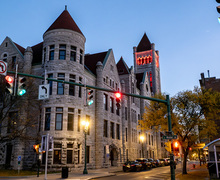Following FAFSA changes, colleges need to help middle income families
Leah Bowman | Contributing Illustrator
College isn't as financially feasible as it used to be. Our columnist advocates for more equitable financial aid that allows students to consider college without costs serving as a barrier.
Get the latest Syracuse news delivered right to your inbox.
Subscribe to our newsletter here.
Last weekend, I watched reruns of “Family Matters,” my favorite comfort show and one that always reminds me of my own family: a Black middle-class family living in the suburbs.
I got to the episode where the eldest daughter, Laura, gets accepted into Harvard University and her father, Carl, tries to figure out a way to pay for her education. He realizes the family makes too much money to qualify for financial aid but not enough to pay Laura’s tuition without going into extreme debt.
As I watched, I reflected on my own experiences applying to colleges and thought of my younger sister as she applies now. I’ve come to realize very little has changed in 30 years.
In fact, it might be getting worse.
Over the past decade, the amount of student enrollment in colleges has decreased, while college tuition is increasing. Between 2010-2020, tuition costs were up by 26%. Here at Syracuse University, the average cost of attendance for this school year is over $87,000. This is a 4.9% increase from the previous year.
The Washington Post classifies a household making anywhere between $68,000-$203,000 as falling within the middle class income bracket, with the average household income in the U.S. being just under $75,000. In states with a high cost of living like Connecticut, where my family is from, a family of four would need to make $83,808 to $250,174 to fall within the middle class.

Cindy Zhang | Digital Design Director
A four-year education at many private institutions like SU, is almost two times more expensive than what the average families are making in one year.
A college education, especially at elite or private institutions, has always been seen as the pathway to financial stability. As society makes many students feel like they need to attend college to achieve career or financial success, it’s no surprise that each year hundreds of thousands of families, regardless of their income bracket, find themselves dealing with the infamous Free Application for Federal Student Aid.
Federal student aid takes into consideration a family’s annual income and assets. It then provides a calculation that colleges use to determine financial aid eligibility for grants, loans, scholarships and work study.
When my parents and I filled out the FAFSA, and toyed around with the Expected Family Contribution calculator in 2021, we were shocked with how much we were expected to pay even at my state’s public university. I was fortunate enough to receive merit aid and merit-based scholarships from most of the schools I had applied to, yet without need-based aid, I had to turn some down. My sister is currently doing the same.
Before 2024, other considerations, such as how many children were attending college in one family, were taken into account as well. But with a Jan. 1 federal law going into effect, FAFSA has overhauled their previous system and this will no longer be taken into account. Legislation like this creates even more financial difficulty for middle class families.
When applying for federal financial aid, many middle class families find themselves being “too rich for aid yet too poor for tuition.” FAFSA has deemed their annual income to be too high to receive aid yet they can’t afford to pay their expected contribution, especially those at private institutions.
Need-based aid programs like the Federal Pell Grant are typically only offered to students with an “exceptional financial need,” but even the amount of Pell Grant recipients at private institutions like SU are decreasing. And with FAFSA’s new updates relying primarily on an income calculation to decide on aid and not much else, the middle class is left with little financial support.
If a student doesn’t receive any merit aid or enough merit aid from schools, they are left to make the decision between turning down a college or drowning in student loan debt. Middle class students are more likely to take out student loans than any other income brackets.
Back in 2017, New York Times’ “Your Money” columnist, Ron Lieber, wrote about a lack of sympathy and support for middle class students trying to afford college. Eight years later, things have seemingly gotten even worse.
While there are nonprofit organizations and advocacy groups doing great work to make higher education more accessible for all, FAFSA and the lack of government support continues to serve as a barrier for many middle class students.
If they choose to opt out of taking on loans, many students are told to turn down their dream schools and attend technical schools over a four-year college. But students shouldn’t have to make sacrifices when it comes to getting a quality education or an education at their institution of choice. Everyone deserves the same opportunities when it comes to higher education, and one’s socioeconomic status shouldn’t be a barrier to that.
While a major part of the solution would be lowering the cost of attendance at many institutions, a fix that simple is unlikely. There needs to be more scholarship opportunities, more government funding toward both public and private colleges for students as well as more people fighting for equitable education costs.
A college education shouldn’t be out of reach just because of the income bracket a student belongs to.
Kaitlyn Paige is a junior studying Public Relations. Her column appears bi-weekly, and she can be reached at kipaige@syr.edu.
Published on February 28, 2024 at 12:04 am






